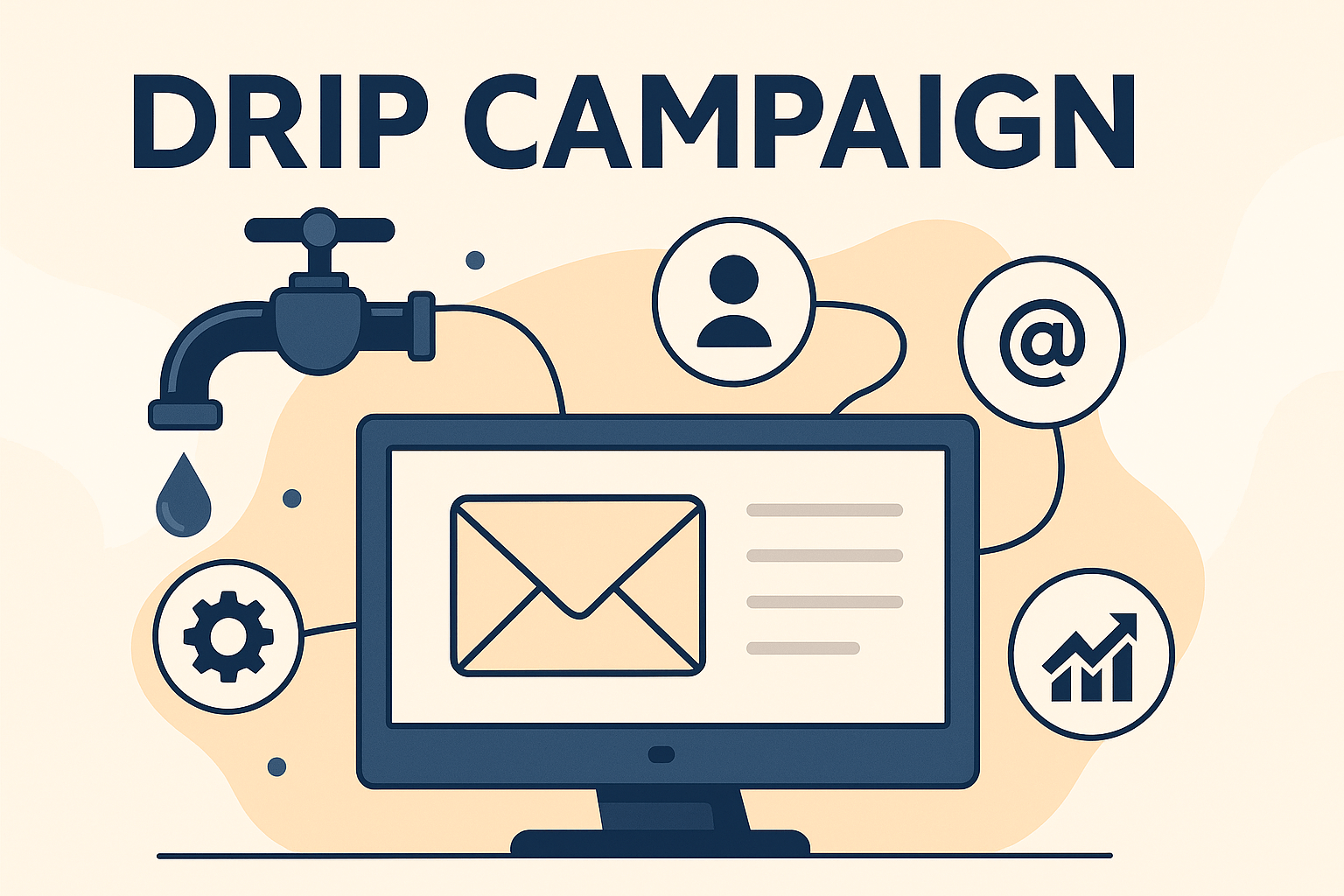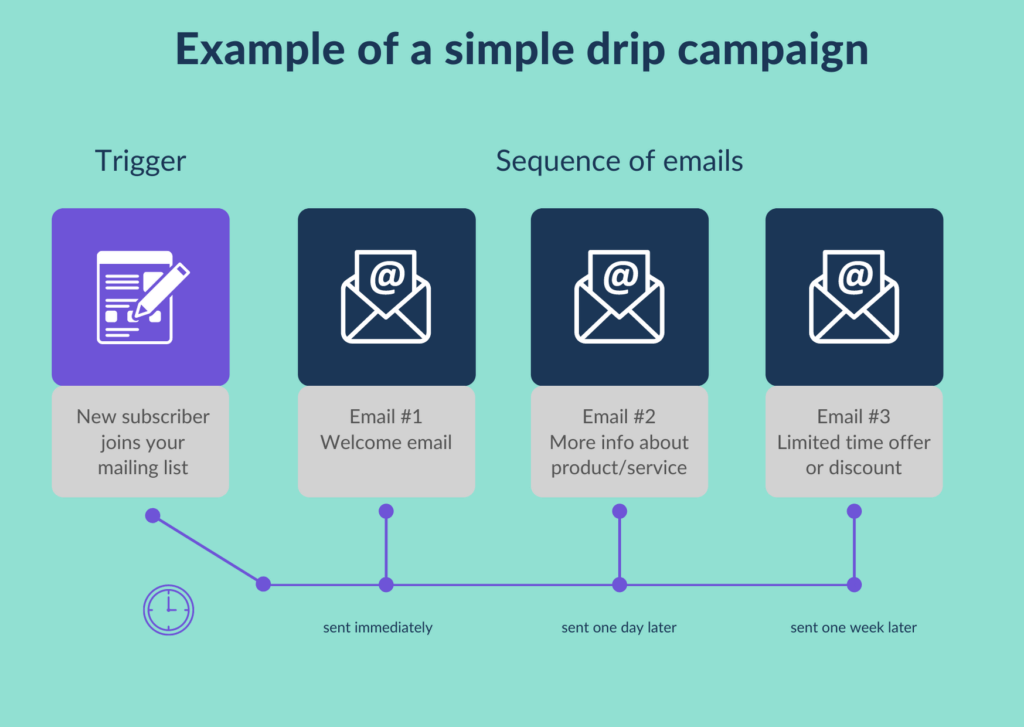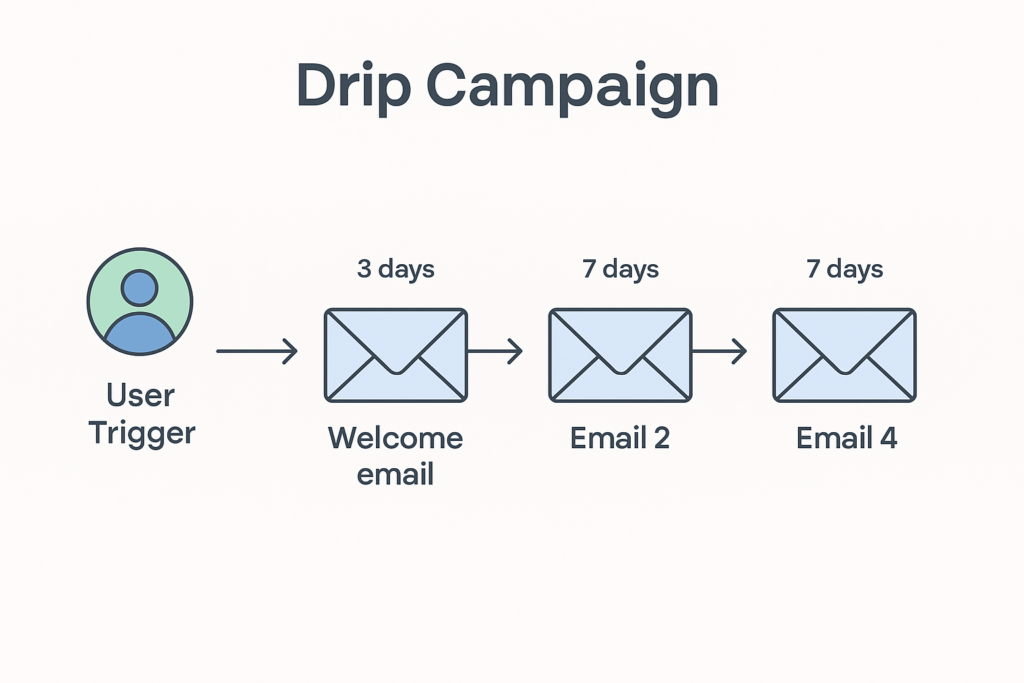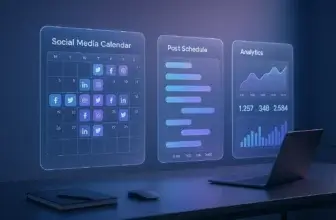
Introduction
Why Drip Campaigns Are a Game-Changer
You’ve probably heard the phrase “right message, right person, right time.” That’s exactly what drip campaigns are all about. They allow you to send the perfect email at just the right moment – automatically.
Instead of sending one-size-fits-all email blasts, you can create a sequence of personalized messages that are delivered over time. Whether you’re welcoming a new subscriber, nurturing leads through a sales funnel, or reconnecting with inactive users, drip campaigns help you guide your audience through their journey – one email at a time.
This strategy isn’t just convenient – it’s incredibly effective. It helps you:
- Build trust through consistent communication
- Drive higher engagement and open rates
- Save time through automation
- Increase conversions with timely CTAs
If you’re serious about optimizing your email marketing, implementing drip campaigns is one of the smartest moves you can make.
What Is a Drip Campaign?
A drip campaign is a series of automated emails that are sent out on a schedule or in response to specific user actions. Think of it like a steady stream of communication, not a flood.
Let’s say someone signs up for your newsletter. Instead of stopping at a single welcome message, a drip campaign might automatically send them:
-
A warm welcome with helpful resources (sent immediately)
-
A follow-up with product tips or blog posts (after a few days)
-
A success story from another user (a week later)
-
A special offer or call to action (after two weeks)
Each email in the series is designed to move the recipient closer to a goal – whether that’s making a purchase, booking a demo, or simply staying engaged with your content.
Drip Campaigns vs. Regular Email Campaigns
You might be wondering how this differs from a traditional email campaign.
Regular email campaigns are usually sent to everyone on your list at the same time. They’re great for announcements or promotions, but not very personal. In contrast, drip campaigns are smarter and more strategic. They respond to user behavior and deliver messages tailored to where someone is in your funnel.
Here’s the bottom line:
- Drip campaigns are automated.
- They’re triggered by specific actions or timelines.
- They’re personalized to match the recipient’s journey.
- They require setup upfront, but minimal maintenance after.
So, instead of shouting into the void, you’re starting a meaningful, ongoing conversation with your audience.

Benefits
Drip campaigns are more than just a trendy marketing tactic – they’re one of the most effective ways to automate communication while keeping it personal. If you’ve ever struggled to keep your audience engaged, or found yourself sending the same follow-up emails over and over again, a drip campaign can be a total game-changer.
Let’s break down the key benefits you’ll experience when you implement a well-crafted drip campaign strategy.
🎯 1. Consistent Lead Nurturing
Drip campaigns help you build trust over time by sending helpful, timely content to your leads – without overwhelming them. Instead of one big email push, you’re nurturing them gradually, which feels much more natural.
📈 2. Improved Engagement and Conversions
Because emails in a drip campaign are targeted and timely, they’re far more likely to be opened and clicked. You’re sending the right content based on what the user has done (or hasn’t done), which leads to better results.
💼 3. Sales Enablement
Your sales team can focus on closing deals while the drip campaign does the heavy lifting – qualifying leads, sharing product information, and warming up prospects.
⏱️ 4. Time and Resource Efficiency
Once you set up your email sequence, it runs in the background 24/7. You can focus on strategy and scaling while your campaign works on autopilot.
📊 5. Data-Driven Optimization
Drip campaigns give you actionable insights. You’ll learn what type of content resonates best, which messages convert, and when people are most likely to engage.
🔍 At-a-Glance: Why Drip Campaigns Work
Here’s a quick summary of the top benefits:
| Benefit | Why It Matter |
|---|---|
| Personalised Automation | Sends the right message to the right person at the right time |
| Higher Engagement Rates | Targeted emails get better open and click-through rates |
| Increased Conversions | Well-timed CTAs help guide users down the sales funnel |
| Time-Saving System | Automates repetitive tasks and reduces manual follow-up |
| Enhanced Customer Journey | Automates repetitive tasks and reduces manual follow-up |
Types of Drip Campaigns
Drip campaigns aren’t one-size-fits-all. Depending on your business goals, customer lifecycle, and audience behavior, you can set up different types of automated sequences that serve specific purposes.
Let’s explore the most common types of drip campaigns you can implement to grow and nurture your email list – whether you’re in e-commerce, SaaS, B2B, or another space.
👋 1. Welcome Drip Campaigns
The first impression counts. A welcome drip introduces your brand, sets expectations, and delivers value upfront.
What it might include:
- A friendly introduction and brand story
- Helpful guides, tools, or onboarding tips
- Links to your best resources or blog content
This type of campaign builds trust from day one and sets the tone for the relationship.
🧭 2. Onboarding Drip Campaigns
Perfect for SaaS or product-based businesses, onboarding campaigns help new users get started quickly and confidently.
What to include:
- Step-by-step instructions for using your product
- Quick wins to showcase value early
- Links to tutorials, knowledge base, or webinars
When your users know how to get value, they’re more likely to stick around.
🛒 3. Abandoned Cart Drip Campaigns
If you’re in e-commerce, this is a must-have. These campaigns recover lost sales by nudging users who added products to their cart but didn’t check out.
Common elements:
- Reminder of the items left behind
- Urgency or scarcity messaging (“Only a few left!”)
- Special incentives like discount codes
💤 4. Re-Engagement Drip Campaigns
Sometimes users go silent – but that doesn’t mean they’re gone for good. Re-engagement campaigns help you win back inactive subscribers or customers.
Effective strategies:
- Personalized “We miss you” messages
- New feature announcements or product updates
- Exclusive offers to re-spark interest
💰 5. Upsell and Cross-Sell Drip Campaigns
Once someone becomes a customer, you don’t stop communicating. You help them get even more value through targeted upsell or cross-sell campaigns.
Example tactics:
- Recommending complementary products or features
- Sharing user stories that showcase upgrades
- Offering bundle discounts or add-ons
Quick Reference: Which Drip Campaign Should You Use?
Here’s a breakdown to help you match the right campaign to your goal:
| Campaign Type | Best Used For |
|---|---|
| Welcome Campaign | Introducing new subscribers and making a strong first impression |
| Onboarding Campaign | Helping users get started with your product or service |
| Abandoned Cart Campaign | Recovering missed revenue in e-commerce |
| Re-Engagement Campaign | Reconnecting with inactive users or leads |
| Upsell/Cross-Sell Campaign | Increasing revenue from current customers |
How to Set Up Drip Campaigns
Creating a drip campaign doesn’t have to be complicated, but it does require strategy. The more thought you put into planning your sequence, the more effective it’ll be in guiding your audience toward your goal.
Here’s a step-by-step guide to help you create a successful drip campaign from scratch.
🧭 1. Define Your Campaign Goal
Before anything else, ask yourself: What do I want this campaign to achieve?
Common goals include:
- Nurturing leads until they’re sales-ready
- Educating new users about your product
- Encouraging repeat purchases or upgrades
- Re-engaging users who’ve gone cold
Having a crystal-clear goal will shape every email you write.
🎯 2. Understand Your Audience
Segmentation is key. Your campaign should speak directly to a specific audience segment. For example:
- New subscribers vs. paying customers
- Trial users vs. long-term clients
- Inactive leads vs. frequent buyers
Use your email platform’s data to tailor content to behaviors, interests, and funnel stages.
📝 3. Map Out the Email Sequence
Plan the number of emails, their content, and the time delay between them.
A simple onboarding drip for a SaaS product might look like this:
- Welcome Email – Thank them for signing up
- Getting Started Guide – Show them the first steps
- Case Study or Social Proof – Build trust
- Advanced Tips or Bonus Feature – Encourage deeper use
- Upgrade Offer or Call to Action – Move them forward
⏲️ 4. Choose the Right Triggers and Timing
Decide what actions will start the campaign and when each email should be sent. Triggers could include:
- Signing up for a newsletter
- Downloading a lead magnet
- Abandoning a cart
- Completing a purchase
Timing is crucial. You want to stay top of mind, without being annoying. Spacing emails 2–4 days apart is usually a good starting point.
🧪 5. Write Your Emails
Each email should focus on a single message, have a clear call to action, and sound like it’s written by a human (not a bot 🤖).
Use storytelling, address pain points, and always provide value.
📊 6. Test, Track, and Improve
Once live, monitor open rates, click-throughs, and conversions. Run A/B tests on subject lines, CTAs, and content to improve performance over time.
Remember: the best drip campaigns evolve based on real data and feedback.
💡 If you’re ready to launch your first automated sequence, tools like Campaigner offer powerful features tailored for drip marketing, especially for businesses scaling their outreach.

Best Practices
Creating a drip campaign is only half the job – the real magic lies in how well you execute it. A well-designed drip campaign can dramatically increase engagement, conversions, and customer loyalty. But get it wrong, and you risk coming off as spammy or irrelevant.
Here’s how to make sure your drip campaigns deliver value, build relationships, and drive results.
🎯 1. Personalize Everything
Your audience expects more than a generic “Hi there.” Use dynamic fields to address users by name, reference their specific actions, or tailor the content to their interests.
Tips:
- Mention products they viewed or actions they took
- Customize based on lifecycle stage or segment
- Use behavior triggers (e.g. downloaded a guide, visited a page)
✅ Remember: Personalized emails have significantly higher open and click-through rates.
📅 2. Nail the Timing and Frequency
Too many emails = unsubscribe. Too few = forgotten. The key is balance.
Best practices:
- Start strong with the first 1–2 emails sent within 48 hours of a trigger
- Space out follow-ups every 3–7 days
- Avoid sending emails too close together unless it’s a limited-time promotion
You can always adjust the schedule based on engagement data.
🔍 3. Keep It Laser-Focused
Each email in your sequence should serve one specific purpose – whether it’s educating, nurturing, or converting.
Ask yourself:
- What is the single action I want the user to take?
- Does this email clearly lead them toward it?
Avoid cramming multiple messages or calls-to-action into one email. Clarity = conversion.
🧪 4. Test and Optimize
Your first version is never the final version. To truly maximize ROI, run A/B tests and refine over time.
What to test:
- Subject lines and preview text
- Email copy and structure
- CTA buttons and link placement
- Send times and intervals
Use your email platform’s analytics dashboard to monitor open rates, clicks, and conversions. Let data guide your decisions.
🔐 5. Respect Privacy and Compliance
Even the best campaign won’t succeed if it violates trust. Make sure your emails follow GDPR, CAN-SPAM, and other data regulations.
Checklist:
- Always include an unsubscribe link
- Only email people who opted in
- Be transparent about what content they’ll receive
When users trust you with their inbox, treat that privilege with care 💬
🧠 Bonus Tip: Segment for Smarter Campaigns
Don’t send the same drip to everyone. Create versions based on:
- Source of signup (e.g. lead magnet, product trial, event attendee)
- Industry or job role
- Behavior (e.g. active vs. inactive users)
Segmentation leads to more relevant emails, which means better engagement and more conversions.
Common Mistakes
Even with the best intentions, it’s easy to make missteps in your drip strategy that can hurt deliverability, frustrate subscribers, or tank conversions.
Here’s a quick overview of what you should and shouldn’t do when running drip campaigns:
| ✅ Do This | ❌ Avoid This |
|---|---|
| Personalise your content | Sending generic, one-size-fits-all emails |
| Space emails thoughtfully | Bombarding users with too many messages |
| Focus on one goal per email | Including multiple CTAs or mixed messages |
| Monitor performance and iterate | “Set and forget” without reviewing metrics |
| Provide value in every email | Pushing sales without offering any benefit |
| Use clear opt-outs and comply with laws | Skipping unsubscribe links or data rules |
🎯 Personalize – Don’t Generalize
A drip campaign should feel like it was written just for the reader. Avoid using bland, impersonal templates. Use their name, refer to their actions, and make the content feel tailor-made.
📅 Be Strategic with Timing
Sending too many emails in a short span overwhelms your audience. On the flip side, waiting too long between emails can cause people to forget who you are. Find a rhythm that keeps your brand top of mind without being pushy.
🧭 One Message, One Goal
Each email should have a clear, single purpose. Don’t confuse your audience with three different offers or five links. Clarity wins every time.
📊 Watch the Data
Once your drip campaign is live, keep an eye on how it performs. Low open rates? Test a new subject line. High unsubscribe rate? Reevaluate your timing or messaging.
Campaigns should evolve based on what the data tells you, not sit untouched.
🎁 Add Value, Don’t Just Sell
People open emails to get something useful, not to hear a constant sales pitch. Include tips, resources, insights, or helpful links that provide real value between your CTAs.
🔒 Respect Your Subscribers
Always include an easy way to opt out. Make sure your list is built from true opt-ins, and stay compliant with GDPR, CAN-SPAM, and other email laws. Building trust starts with respecting privacy.
Conclusion
Start Dripping with Confidence
Drip campaigns are one of the most powerful tools in your email marketing arsenal. They allow you to connect with your audience in a way that’s personalized, timely, and efficient – all while running on autopilot.
Whether you’re welcoming new subscribers, guiding users through onboarding, or bringing inactive customers back to life, a well-structured drip campaign helps you build relationships that convert. When done right, it’s like having a 24/7 sales and support team built into your inbox. 💌
To recap, here’s what makes a great drip campaign:
- Clear goals and user segmentation
- Thoughtful timing and sequence
- Personalized content with one goal per message
- Ongoing testing and optimization
- Respect for privacy and compliance
Ready to take your email strategy to the next level? 💡
Don’t forget to check out our guide to the Best Email Marketing Tools to find the perfect platform for setting up your next high-performing drip campaign.
You’ve got the knowledge – now go create sequences that convert! 🚀
FAQ
1. What is a drip campaign in email marketing?
A drip campaign is an automated series of emails sent based on user actions or timelines. It helps you nurture leads, onboard users, or drive conversions through strategic communication.
2. How many emails should be in a drip campaign?
Most effective drip campaigns include 4 to 7 emails, spaced a few days apart. The ideal length depends on your goal, audience, and user engagement.
3. What’s the difference between drip and regular email campaigns?
Drip campaigns are automated and behavior-based, sent over time. Traditional campaigns are one-time sends to your entire list without targeting or timing triggers.
4. What tools are best for creating drip campaigns?
Popular tools include Klaviyo, Brevo, Mailchimp, and ActiveCampaign, each offering automation features ideal for building smart drip campaigns. Or you can read our full article about Best Email Marketing Tools and try the one that suits you most.






